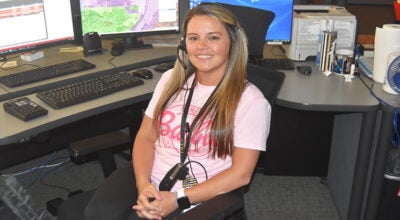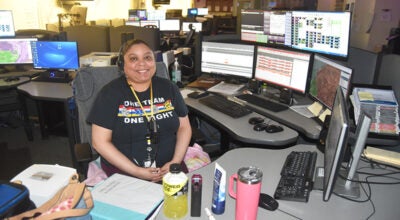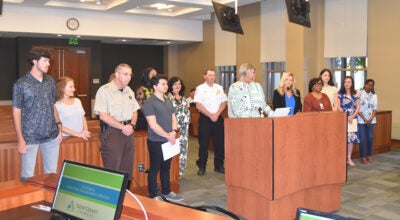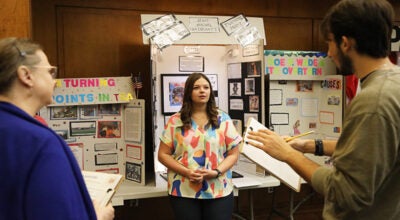Communities in Schools continues to grow
Published 9:09 pm Friday, March 16, 2018
In 2018, the Communities In Schools program in Troup County has undergone staggering growth, with the total students served by the program rising from 960 in 2017 to 2,864 in 2018.
According to Tabitha Coverson, the executive director of Communities In Schools of Georgia in Troup County, that number is poised to hit the 3,000 mark by the end of the year thanks to community support. Communities In Schools has been helping students in Troup County for 29 years, and has grown to serve the three middle schools within LaGrange City limits, as well as Berta Weathersbee Elementary School, which faced disciplinary concerns last year.
“At one point during the school year [last year], we were down to one school,” Coverson said. “We are now in four schools. All three middle schools, and I also have two AmeriCorps members at Berta Weathersbee working with those students because it was one of our high need schools. [They are] working with those students to help them get on grade level in reading and math.”
CIS focuses on building relationships between parents, schools and teachers to meet children’s needs, and local representatives say that they have seen clear improvement when parents simply know what they need to do to help their children.
Parents aren’t the only ones becoming more involved though. In 2017, CIS reported 189 volunteer hours. In 2018, the organization has reported 1,430 volunteer hours. That is in addition to so many donations that Coverson requested that anyone who has free time come to help her sort three rooms full of donations for students when they are available.
“Communities In Schools is a stay in school program,” Coverson said.
“We work with students to overcome any barriers that they might have to education that they might have. Some are straight A students, and some have academic issues. Some have attendance issues. Some have behavior issues. Whatever the case may be, we work with those students, so that their sole focus is academics. They can sit in the classroom and learn and interact appropriately with their peers.”
For some students that means providing something even as basic as soap and an opportunity to take a shower before school. For other students, it means having an adult to talk to about problems from other parts of their life that can impact children at school.
“In sixth grade, there were a lot of fights in that school, but since Mr. Mark came, he has solved the problem and tells you what to do,” said J’Arthur Dunn, a peer role model for CIS. “The same boys cut up less in class, and there is less violence.”
The local program experienced some turbulence in 2017, with low volunteer support and was only able to cover Long Cane Middle School.
“We went through some changes last year,” Coverson said. “I got down to one site coordinator, one school, and then midway through the year we made a decision to dissolve our local 501c3 and join the state office. We are now Communities In Schools of Georgia in Troup County.”
Now, all donations from within the county still remain in the county and CIS now has a larger support network to help determine how to best help students.
“At Callaway Middle School, what we are focusing on is increasing our literacy rate, so assistance with the teachers who are on staff there,” said Stephanie Williams, a site coordinator for CIS. “[We are] focusing on the basics of literacy starting with ground one phonics, compound words, nouns, verbs and creating a building block where our students are going to become better readers and helping them to better understand the information that is presented to them in class.”
That process also feeds into behavior as well.
“Through that process, it is also working to decrease the behavior as well,” Williams said. “Children act out when they know that they are not as familiar as their peers when it becomes time to read or reading out loud or understanding the information.”
Councilmembers asked about CIS partnership with the Troup County School System, which Coverson said was extremely supportive of the program.
“Having those one on one relationships with them, getting them during times when they are not in school — those summer hours — connecting them with the community is key,” said Sequita Freeman, the chief human resources officer for the TCSS and advisory board member for CIS. “Tabitha [Coverson]’s done a fabulous job. We’ve got some awesome site coordinators who have been here and have been dedicated to the program.”
The program is financially supported by the city and the school system. It has also received funding from the Callaway Foundation and AT&T this year.
“I’ve done some checking, and it is right on target,” Councilmember Willie Edmondson said. “Gardner Newman because of your program — I have found from and inside source — that they are doing very well. Berta Weathersbee, I understand that school has turned around because of some of the things that you are doing there, and I just want to thank you. It is not our responsibility [as the city council] to do anything with the school system, but this is money that we have put out there that I think is wonderful.”
Coverson said that while CIS does not have coordinators in Troup County high schools at this time, but it does what it can for students in the high schools, especially students who were in the program in middle school.
She hopes to expand to serve more elementary schools with the program with the help of AmeriCorps in the future.
To learn more about Communities In Schools of Georgia in Troup County, visit http://www.cistroupcounty.org/site/.





